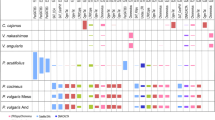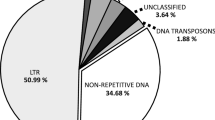Abstract
A tandemly repetitive sequence family (AbS1) and a repetitive sequence (Hd) forming part of a larger dispersed element (dorf-1) ofAnemone blanda were characterised. TheAbS1 satellite sequence family is located in all 4′,6-diamidino-2-phenylindole (DAPI) positive intercalary heterochromatic bands and in the DAPI positive heterochromatic terminal region of chromosome 3, while the dispersedHd homologous sequences are preferentially associated with euchromatic chromosome regions. The major component of theAbS1 satellite isAbS1-H1 with a basic repeat unit of 1640 bp; a minor fraction (AbS1-H5) consists of 320 bp units. A subsection of theAbS1-H1 repeat unit exhibits homologies to the 25S rRNA gene of flowering plants suggesting that the 1.64 kb satellite was generated by amplification of a precursor satellite and/or single copy sequence together with an rDNA fragment. The rDNA homologous region is considered to evolve at a rate similar to pseudogenes and thus the age of this satellite DNA fraction can be roughly estimated as about 27 million years.
The dispersed repeated sequenceHd (about 1300 bp) is associated with the 8 kb elementdorf-1. A. blanda dorf-1 constitutes about 0.2% of the genome (3×104 copies), is bounded by identical long terminal repeats, and exhibits partial homology to theLilium gypsy-type elementdell, but has yet to be confirmed as a retrotransposon. In contrast to theAbS1 satellite sequence family,Hd homologous sequences were found not only inA. apennina, the closest relative ofA. blanda, but also inA. nemorosa andA. ranunculoides indicating that a progenitor sequence ofdorf-1 was present in a common ancestor before speciation ocurred.
Similar content being viewed by others
References
Baumberger H (1970) Chromosomenzahlbestimmungen und Karyotypenanalysen bei den GattungenAnemone, Hepatica undPulsatilla Berichte der Schweizerischen Botanischen Gesellschaft 80: 17–95
Bedbrook JR, Jones J, O'Dell M, Thompson RD, Flavell RB (1980a) A molecular description of telomeric heterochromatin inSecale species. Cell 19: 545–560
Bedbrook JR, O'Dell M, Flavell RB (1980b) Amplification of rearranged repeated DNA sequences in cereal plants. Nature 288: 133–137
Böcher TW (1945) Meiosis inAnemone apennina with special reference to chiasma localisation. Hereditas 31: 221–237
Bonner TI, Brenner DJ, Neufeld BR, Britten RJ (1973) Reduction in the rate of DNA reassociation by sequence divergence. J Mol Biol 81: 123
Cullis CA, Schweizer D (1974) Repetitious DNA in someAnemone species. Chromosoma 44: 417–421
Dellaporta SL, Wood J, Hicks JB (1983) Plant DNA minipreparation: version II. Plant Mol Biol Rep 1: 19–21
Flavell RB (1982) Sequence amplification, deletion and rearrangement: Major sources of variation during species divergence. In: Dover GA, Flavell RB (eds) Genome evolution. Academic Press, London, pp 301–323
Flavell AJ, Smith DB, Kumar A (1992a) Extreme heterogeneity ofTy1-copia group retrotransposons in plants. Mol Gen Genet 231: 233–242
Flavell AJ, Dunbar E, Anderson R, Pearce SR, Hartley R, Kumar A (1992b)Ty1-copia group retrotransposons are ubiquitous and heterogeneous in higher plants. Nucleic Acids Res 14: 3639–3644
Gorski JL, Gonzales IL, Schmickel RD (1987) The secondary structure of human 28S rRNA: The structure and evolution of a mosaic rRNA gene. J Mol Evol 24: 236–251
Grandbastien M-A (1992) Tetroelements in higher plants. Trends Genet 8: 79–118
Gründler P, Unfried I, Pointner R, Schweizer D (1989) Nucleotide sequence of the 25S-18S ribosomal gene spacer fromArabidopsis thaliana. Nucleic Acids Res 17: 6395–6396
Huijser P, Hennig W (1987) Ribosomal DNA-related sequences in a Y chromosomal lampbrush loop ofDrosophila hydei. Mol Gen Genet 206: 441–451
Kolosha VO, Kryukov VM, Fordor I (1986) Sequence analysis ofCitrus limon DNA coding for 26S rRNA. Evidence of heterogeneity in the 3′-region. FEBS Lett 197: 89–92
Komma DJ, Endow SA (1986) Magnification of the ribosomal genes in femaleDrosophila melanogaster. Genetics 114: 859–874
Lang BF, Burger G (1986) A collection of programs for nucleic acids and protein analysis, written in Fortran 77 for IBM-PC compatible microcomputers. Nucleic Acids Res 14: 455–466
Li WH, Graur D (1991) Fundamentals of molecular evolution. Sinauer Associates, Publishers, Sunderland, Massachusetts
Li WH, Luo CC, Wu CI (1985) Evolution of DNA sequences. In: MacIntyre RY (ed) Molecular evolutionary genetics. Plenum, New York, pp 1–94
Lohe AR, Roberts PA (1990) An unusual, Y chromosome ofDrosophila simulans carrying amplified rDNA spacer without rRNA genes. Genetics 125: 399–406
Luschnig C, Bachmair A, Schweizer D (1993) Intraspecific length heterogeneity of the rDNA IGR inArabidopsis thaliana due to homologous recombination. Plant Mol Biol (in press)
Marks GE (1976) Variation of Giemsa banding patterns in the chromosomes ofAnemone blanda L. Chromosomes Today 5: 179–184
Marks GE, Schweizer D (1974) Giemsa banding: Karyotype differences in some species ofAnemone and inHepatica nobilis. Chromosoma 44: 405–416
Meinkoth J, Wahl G (1984) Hybridization of nucleic acids immobilized on solid supports. Anal Biochem 138: 267
Meyerowitz EM (1992) Introduction to theArabidopsis genome. In: Koncz C, Chua N-H, Schell J (eds) Methods inArabidopsis research. World Scientific, Singapore, pp 100–118
Pinkel D, Straume T, Gray JW (1986) Cytogenetic analysis using quantitative, high-sensitivity, fluorescence hybridization. Proc Natl Acad Sci USA 83: 2934–2938
Rothfels K, Sexsmith E, Heimburger M, Krause MO (1966) Chromosome size and DNA content of species ofAnemone and related genera (Ranuncylaceae). Chromosoma 20: 54–74
Sambrook J, Fritsch EF, Maniatis T (1989) Molecular cloning: A laboratory manual, second edition. Cold Spring Harbor Laboratory Press, Cold Spring Harbor, NY
Schmidt-Puchta W, Guenther I, Saenger HL (1989) Nucleotide sequence of the intergenic spacer (IGS) of the tomato ribosomal DNA. Plant Mol Biol 13: 251–253
Schweizer D (1980) Fluorescent chromosome banding in plants: Applications, mechanisms, and implications for chromosome structure. In: Davies DR, Hopwood DA (eds) The plant genome. The John Innes Charity, John Innes Institute, Norwich England, pp 61–72
Schweizer D, Strehl S, Hagemann S (1990) Plant repectitive DNA elements and chromosome structure. Chromosomes Today 10: 33–43
Smyth DR (1991) Dispersed repeats in plant genomes. Chromosoma 100: 355–359
Smyth DR, Kalitsis P, Joseph JL, Sentry JW (1989) Plant retrotransposon fromLilium henryi is related toTy3 of yeast and the gypsy group ofDrosophila. Proc Natl Acad Sci USA 86: 5015–5019
Unfried I, Gruendler P (1990) Nucleotide sequence of the 5.8 S and 25S rRNA genes and of the internal transcribed spacers fromArabidopsis thaliana. Nucleic Acids Res 18: 4011
Author information
Authors and Affiliations
Additional information
Commicicated by: M.L. Pardue
Rights and permissions
About this article
Cite this article
Hagemann, S., Scheer, B. & Schweizer, D. Repetitive sequences in the genome ofAnemone blanda: Identification of tandem arrays and of dispersed repeats. Chromosoma 102, 312–324 (1993). https://doi.org/10.1007/BF00661274
Received:
Revised:
Accepted:
Issue Date:
DOI: https://doi.org/10.1007/BF00661274




